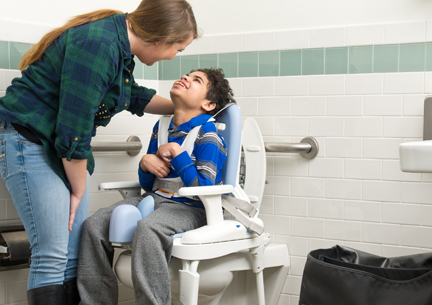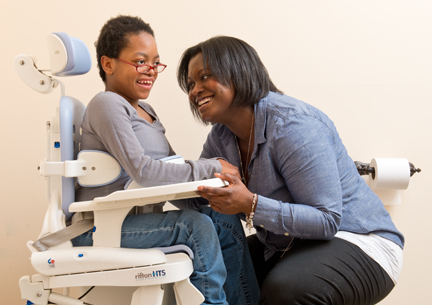Toileting Tips for Children with Disabilities
Lori Potts, PT discusses positioning concepts for toileting and demonstrates them using the Rifton HTS (Hygiene & Toileting System).
Positioning
Today we want to talk about positioning when toileting.
This can be very important for children and young adults with disabilities, to help them be successful when they are on the toilet. Here in our Western culture we typically have regular toilets, but research is actually showing that the squatting position is better and more effective for successful toileting. What happens when we squat is that the position of the pelvic floor muscles change, and our rectum is actually better aligned to allow gravity to help us with that process of the bowel movement; and that’s how we want to set up our children with disabilities so that they can be more successful in toileting.
Toilet Seat Insert
So let’s think about positioning children on the toilet in such a way that we mimic that squatting position. For many children, all they need is a toilet seat insert to give them a little bit more stability and security on the toilet. This might sit right on the toilet seat, or you might flip the seat up and set it right on the toilet bowl, but that would allow them to be in a relaxed sitting position and void. By placing a stool in front of the toilet, we can make sure that their knees are raised relative to their hips. The higher their knees, the more hip flexion. We can also encourage the child to lean through their forearms, and that will mimic the squatting position.
Adaptive Toilet Seat
Now for a child with more significant disabilities, they may need an adaptive toilet seat for support; and we can look at how we position the product, again to help promote that squat. For one, we can alter the amount of tilt in the seat. Find the position that allows the child to relax while they’re sitting, and then intentionally bring the backrest angle forward. You can see the little marking on the side where it will click into a forward leaning position. We can also shorten the seat depth just for the toilet, because that will bring their knees a little forward; and then we can raise the footrest, again to jack their knees a little higher than their hips. We can change the angle of the footboard to find what’s most suitable for that child. Using the anterior tray then gives the child a secure position for leaning forward, so really this then mimics that squatting position; and if you do have the tilt-in-space, you can adjust that – because the hip and knee angle will remain the same regardless of the tilt. So that will find the position that’s going to be comfortable for the child. In some cases the toilet seat is used directly on the toilet itself or rolled over an actual toilet.
Toileting System Accessories
So besides getting the toilet seat itself in the optimal toilet position, you would also want to consider the accessories that you use to make sure the child is secure, stable and comfortable. For example, we have the hip guides that attach right on the armrests, and those can achieve the right seat width for the child. We have lower extremity supports, including an abductor to separate the knees, and then a deflector that can be used in conjunction with the abductor, as well as the splash guard option. For the trunk and the head there is the butterfly harness that secures across the seat belt, and the adjustable headrests as well. There are more accessories besides this. Please check out the website www.rifton.com for the Hygiene & Toileting System and learn about the positioning options. Our customer service is ready to help you. And all the best as you toilet your child with special needs.




